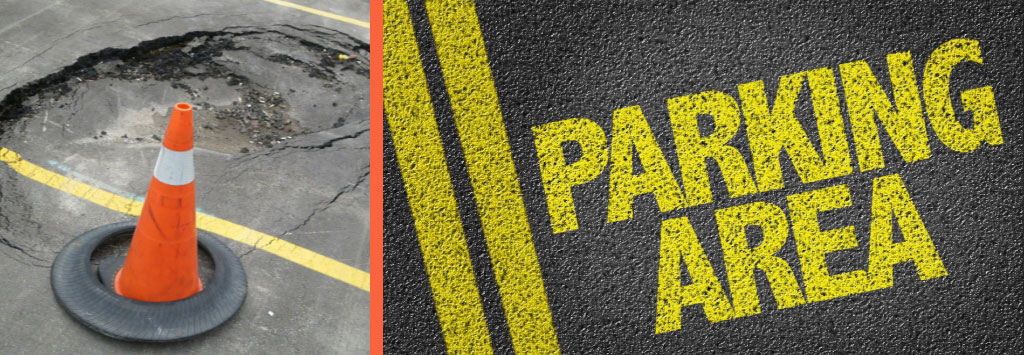Preventing Exterior Slips, Trips, and Falls at Your Business
Parking lots and walkways can present the risk of personal injuries and property damage for businesses. Whether you own or lease your commercial property, it's your responsibility as a business owner to stay vigilant and take a proactive approach to keeping your employees and customers safe while on the property.

Though you can’t control environmental conditions that increase the risk of slips and falls, you can reduce the likelihood of falls through regular exterior property audits, improved layout and design, and regular maintenance.
Here are 9 areas to focus on to help mitigate slips, trips, and falls at your business.
1. Ensure Adequate Lighting
This might seem obvious, but make sure your commercial property is adequately illuminated. Overhead lights should be positioned to sufficiently illuminate all parking spaces and pedestrian walkways. Burnt-out light bulbs should be immediately reported and replaced. Don’t rely on customers reporting burnt-out lights — make sure you walk your property regularly (and at night!) to ensure the exterior of your property is well-lit.
2. Install Video Surveillance
Make sure you have a video surveillance system that covers the most heavily traveled pedestrian areas of your property. Implement a storage recording policy so recordings can be retrieved for a reasonable amount of time. We recommend at least 30 days, but the longer the better. Some vendors use cloud technology that can store video for a long time. Video surveillance can be helpful to determine what happened if a slip and fall claim is filed against you.
3. Keep the Parking Lot Clean
Trash and other debris should be picked up regularly. This includes landscaping items like rocks and wood chips in pedestrian walkways. Make parking lot inspections part of your team’s daily maintenance activities and document when this is done. Anything out of place can act as a tripping hazard not only for customers, but for your teammates as well.
4. Provide Easy Access to Trash Cans and Smoking Urns
Providing customers easy access to exterior trash cans and smoking urns is a proactive way to minimize parking lot debris. Consider the type of trash can and placement depending on your location and business needs. If you operate a drive-through, can your customers throw trash away without getting out of the car? Are the trash cans secured enough to prevent critters from getting in and littering your parking lot with debris? Make sure trash cans and smoking urns are easily accessible for customers but are also secure enough that they don’t create more debris or hazards in the parking lot themselves. Your checklists should make sure that trash receptacles are emptied regularly.
5. Implement Water Drainage Control
Inspect gutters, sprinklers, and water systems around the parking lot and any pedestrian walkways around your building. You want to run gutter systems and downspouts away from pedestrian walkways and parking lots. Water running over or into areas where customers and employees walk can create potential slip hazards, especially during cold months when the water might freeze. You also want to ensure proper water drainage around the property. Pooling water can lead to erosion and additional hazards, leading to even more problems than just a liability claim.
6. Repair Potholes and Deteriorated Pavement
Conduct regularly scheduled parking lot audits and identify areas where repair and maintenance are needed. During seasons of more extreme weather and temperature changes, audits should be completed more frequently. If areas are identified for repair, place signage on or near the area to either warn or help prevent customers from injuring themselves or damaging their vehicles while you are coordinating repairs.
7. Parking Lot lines and Markings
If the stripes in your parking lot are fading, chipping, or difficult to see, it’s time to restripe your parking lot. The frequency to check the striping can vary depending on your area; however, it’s best practice to check your parking lot lines and markings every six (6) months. You will also want to review local ordinances to ensure appropriate ADA-compliant parking spaces are provided in adequate numbers and are properly marked. Keep in mind some local ordinances also have legal requirements for the color, size, and shape of handicap stall markings.
8. Maintain Pedestrian Walkways
Sidewalks, ramps, and other pedestrian walkways should be properly maintained and designed safely. Pedestrian signage and crosswalk markings not only help pedestrians understand where to walk safely, but they also alert drivers to be on the lookout for pedestrians.
9. Mark Steps and Curbs
Demarcate steps, curbs, and any quick elevation changes with high-visibility paint. This will help pedestrians and drivers better see steps and curbs. Check with local ordinances for specific requirements related to colors and placement of markings.
Do You Lease Your Property?
If you lease your property, review your lease agreement to determine who is responsible for controlling gutters, sprinklers, parking lot maintenance, lighting, etc. If it’s your landlord, make sure you promptly report any issues found and report these in writing to help protect your business from any general liability claims filed against you because of conditions that your landlord is responsible for.
Taking a proactive approach in these 9 areas will help ensure your employees and customers are kept safe while on the property.
Categories
Recent Posts

Request a Quote
Ready to take control of your insurance? Request a quote and get the coverage you need all in one place. Remember your broker can’t access us and we don’t interfere with their marketing.